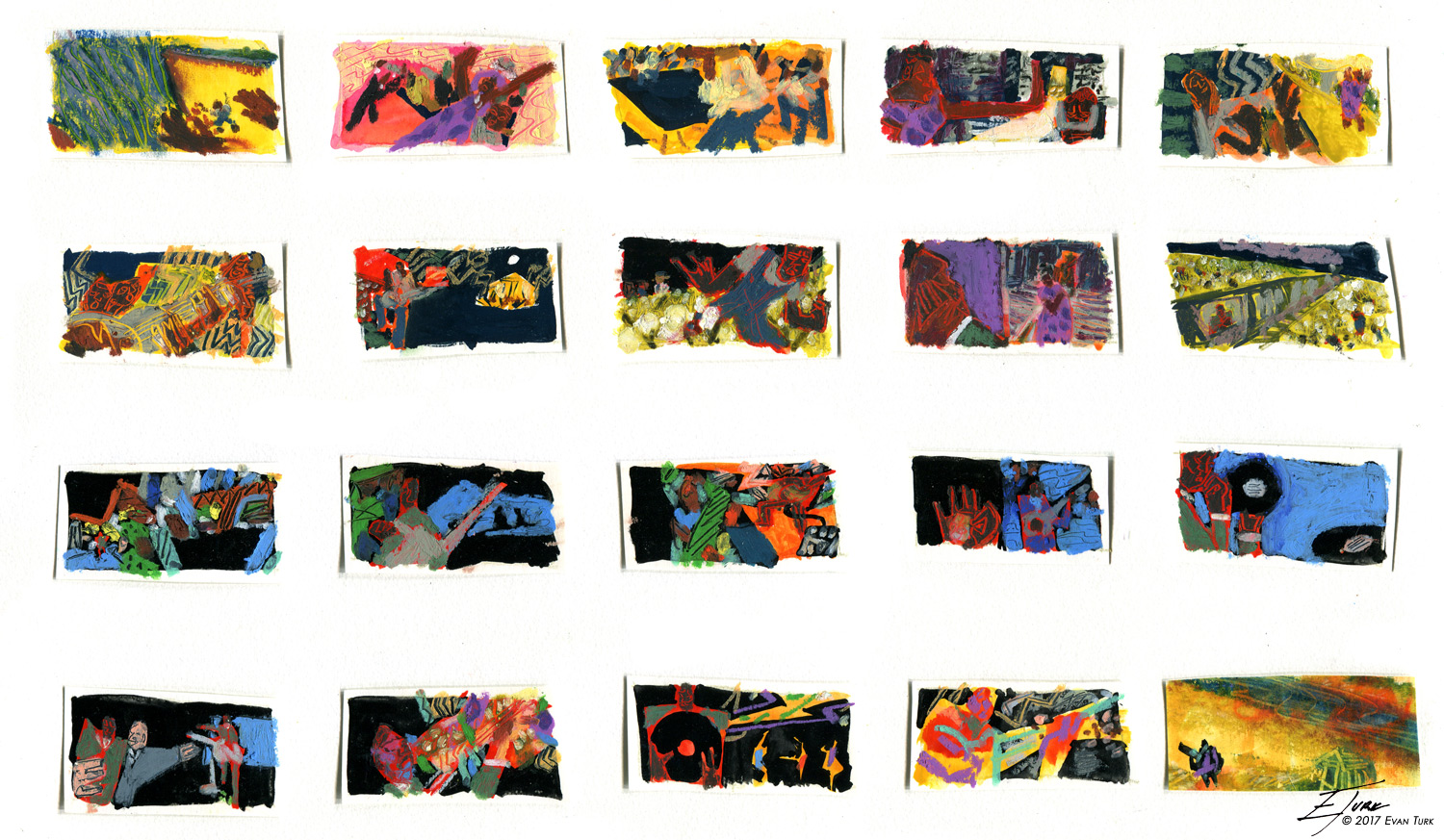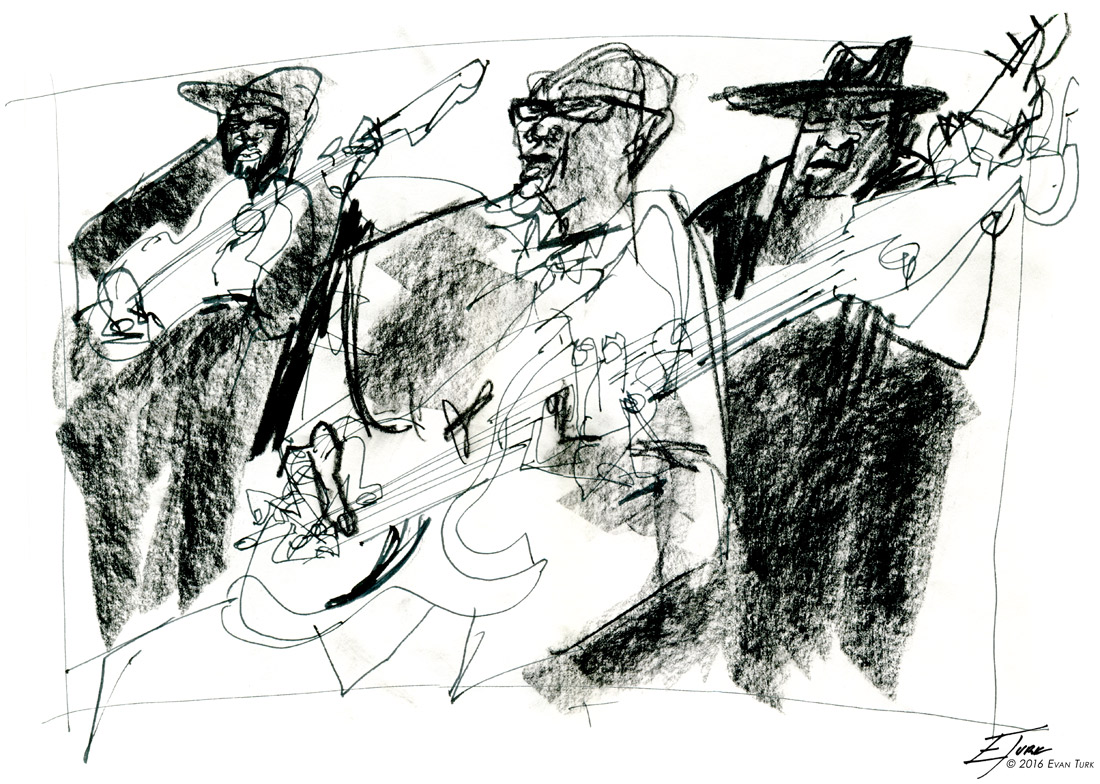The blues research continues! I am working on the illustrations for an upcoming book called
Muddy by Michael Mahin, which tells the story of blues musician Muddy Waters. After traveling to Mississippi in the fall to learn about Muddy's roots, it was time to go to Chicago to see where he became a musical legend. The blues community that Muddy helped develop in Chicago is still active and thriving. It was interesting to feel how Chicago's blues retain the same feeling of the Mississippi Delta, though the settings couldn't be farther apart.
My first stop was
Blue Chicago to hear the
Tenry Johns Band featuring
Claudette Miller. Like Muddy Waters, Tenry Johns is originally from a small town in Mississippi, and you can feel the country blues in his playing. He and his band were high energy, light-hearted, and charismatic from beginning to end.
It's always interesting to try and see the different personalities of the different instruments and roles in a band. Tenry, the front man, was all smiles and laughing (upper right). The other two guitarists were quieter and focused.
From my vantage point, all I could see of the drummer was his head poking up over the cymbals.
Later in the evening they were joined by the wonderful Claudette Miller, whose smokey voice was both sultry and playful. She was kind enough to chat with me for a little while after her set, and gave me the names of more great blues artists I should know. The blues community here is very tight-knit and passionate.
Their energy was infectious and got the crowd off their seats and dancing.
The next day I went to visit the former site of Chess (Aristocrat) Records, the studio where many of the greats, including Muddy Waters, recorded their hits. The building is now the site of the
Willie Dixon Blues Heaven Foundation started in honor of Willie Dixon, the musician and songwriter behind many of the biggest blues hits of the 50's and 60's ("Hoochie Coochie Man," "I Just Want To Make Love To You," "My Babe"). The Foundation now seeks to preserve the history of the blues in Chicago, while encouraging and educating young musicians about the business. The Dixon family still runs the foundation—Dixon's knowledgeable and friendly grandson, Keith, volunteers and offers tours—and awards scholarships to students in Chicago. The studio has also become a mecca for musicians such as the Rolling Stones and Steven Tyler to come and soak up the residual blues energy.
That night I went to go see the
Mike Wheeler Band at
Kingston Mines. These guys electrified the stage, and really gave their all. You could feel the passion in their playing.
The band was then joined by the amazing
Peaches Staten who added her intensity and powerful, growling vocals.
At one point, she did a rubboard solo where she strummed and scraped across the metal ridges of the board for rhythm, all while singing and dancing on stage. She was a powerhouse!
So much intensity on one stage!
After her set, Peaches went onto the dance floor and got the rest of the crowd moving and shaking.
The next day it was all about
Buddy Guy's Legends club. Among his many accolades, Buddy Guy is the recipient of six Grammys and the National Medal of Arts. Early on in his career in the 60's, he played alongside Muddy Waters. Now, at the age of 79, and with the recent passing of B.B. King, he is one of the last torchbearers of this generation of blues. Needless to say, he has quite a few fans. So to make sure I had a good spot, I had to get to his club eight hours early (and tables were already filling up by that point). Fortunately, there were some fantastic acts throughout the day. I arrived in the middle of Eddie Taylor Jr.'s set. Son of Chicago bluesman Eddie Taylor, he carries on his father's trade.
His sound was less electrified rock, more country blues, and reminded me of Muddy's Folk Singer album. His singing and playing are subtle, strong, and sensitive.
When his set was over, there was a few hours before the next performer, so I passed the time drawing the crowd ordering more and more drinks as they waited.
Next up was
Nicholas Barron with an unusual, percussive singing style combined with a deep, gravelly, soulful voice.
A visual artist as well, his guitar was covered with beautiful swirling patterns.
His second set that he played a bit later was even more powerful, where he really let loose and let his voice fly.
Then it was time for the opening act, Vino Louden. This guy was, straight out of the gate, so full of energy it was hard to keep up. He commanded the stage with an unbridled, sensual electricity.
Louden was a guitarist for the late blues singer Koko Taylor, and at one point in the show he told of how he and the rest of her band were in a terrible car accident. Louden was the worst off, with a severely broken pelvis, life-support, and two heart attacks. But through a painful rehabilitation, he relearned how to move his body, and regained his life. He sang a moving and plaintive rendition of Sam Cooke's "A Change Is Gonna Come".
Maybe it's because of that hard-won and fought-for life that his performance was so full of vitality. You could tell he was
feeling every single note he played.
His keyboardist, too, had some particularly jaw-dropping solos.
Absolutely blown away by Vino and his band, I couldn't wait for what was coming next.
To a roaring cheer, Buddy Guy entered the stage in a red and black polka dot shirt. Polka dots are Buddy's trademark. With his parent's encouragement, he left Louisiana for Chicago, and promised his ill mother that he would buy her a polka dot Cadillac one day. But she passed away without ever getting to see him play, so he wears the polka dots as a reminder of his promise to her.
At 79, he is somewhat unassuming. But once he starts to speak, or sing, or play, he grows 10 feet in a second.
I loved watching his face as he sang, spoke, and played, shifting from one second to the next from intense focus, to a wry, curled grin, to a state of spiritual ecstasy.
What struck me the most about watching him perform, was that drawing his actual presence on stage almost became beside the point. He was so in tune and skillful with the guitar and the joyful theatrics of his playing, that he dissolved away, and all that was left was this screaming, howling intensity of sound. His voice, from gentle, pained weariness to primal screams, melted into bare emotion.
Near the end of the show, he went on a tour of the bar, disappearing into the crowd except for flashes of red and polka dots. But as he literally disappeared behind his throngs of adoring fans, his sound filled the room, like he was in every single corner at once.
Before Buddy came out, the MC told the audience how this club, and this performance were the result of a promise. Buddy, Muddy Waters, B.B. King, Bryan Lee, and Junior Wells promised each other that they would do their best to keep the blues alive. With his unparalleled intensity, skill, and passion, Buddy Guy is doing just that.

The promise, though, reminded me of my last stop in Chicago: Muddy Waters' house on the West Side. The house now sits abandoned, marked with a red X to show that it is not structurally sound. The windows are boarded up. As I drew outside, crouched near a lamppost as it started to snow, many
neighborhood kids came by and asked why I was drawing the house. I told
them about Muddy Waters, and pointed them to the weathered Blues Trail sign behind
me talking about his history. The house has been saved from demolition, and many have talked about turning the house into a Blues museum. But none so far have been successful, and its future remains uncertain. The history of the blues is integral to the history of not just American music, but America itself. Whether through Buddy's club, Muddy's house, or Willie Dixon's foundation, it is important that we keep this history alive to educate future generations.
For
more of Evan Turk's travel illustration, check out the link below:








































































